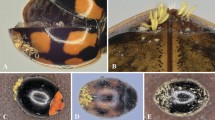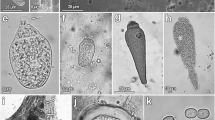Abstract
Lacewings are known as biological control agents, substantially reducing populations of aphids and spider-mites. The study focuses on gregarines parasitizing their brown lacewing hosts. The occurrence of the gregarine species Hyalospora hemerobii Geus, 1969 in brown lacewings (Hemerobiidae) in NE Slovenia was investigated. Seven brown lacewing species were surveyed and in five of them (Hemerobius humulinus, H. micans, H. marginatus, Micromus variegatus and Sympherobius pygmaeus) gregarines were present. Trophozoites, solitary gamonts, associations, syzygies and gametocysts were recognized. In this paper syzygy of H. hemerobii is illustrated for the first time. In some trophozoites the epimerite was present, associations were biassociative and caudofrontal. The occurrence of the parasite in Hemerobius micans was studied in 2011 and 2013. In 2011, gregarines occurred from June to September, and in 2013 from June to October. An infection rate within the range of 10–86.7% was detected. The average number of solitary gregarines per infested host increased progressively, from June to September/October. This is the first investigation of seasonal patterns in the occurrence of any known gregarine species parasitizing Neuropterida.
Similar content being viewed by others
References
Achtelig M. 1974. Entwicklung von Gregarina raphidiae n. sp. (Sporozoa, Eugregarinida) aus dem Darm der Larven der Gattung Raphidia (Insecta, Raphidioptera). Arch. Protistenkde. 116: 80–98.
Achtelig M. 1975. Zur Feinstruktur und Funktion der Sporodukte von Gregarina raphidiae Achtelig (Sporozoa, Eugregarinida). Arch. Protistenkde. 117: 54–59.
Alarcón M.E., Huang C.-G., Dubey A.K. & Benítez H.A. 2013. A gregarine from the gut of cat flea, Ctenocephalides felis (Bouché) (Siphonaptera: Pulicidae) in Taiwan: dynamics of infection patterns. Vet. Parasitol. 192(1–3): 51–56. DOI: 10.1016/j.vetpar.2012.10.020
Albicócco P.A. & Vezzari D. 2009. Further study on Ascogregarina culicis in temperate Argentina: prevalence and intensity in Aedes aegypti larvae and pupae. J. Invertebr. Pathol. 101(3): 210–214. DOI: 10.1016/j.jip.2009.05.003
Avelar D.M. & Linardi P.M. 2008. Seasonality and prevalence rates of Steinina sp. (Eugregarinorida: Actinocephalidae) in Ctenocephalides felis felis (Siphonaptera: Pulicidae) from dogs captured in Belo Horizonte, Minas Gerais, Brazil. J. Med. Entomol. 45(6): 1139–1142. DOI: http://dx.doi.org/10.1603/0022-2585(2008)45[1139:SAPROS]2.0.CO;2
Bunker B.E., Janovy J. Jr., Tracey E., Barnes A., Duba A., Shuman M. & Logan J.D. 2013. Macroparasite population dynamics among geographical localities and host life cycle stages: eugregarines in Ischnura verticalis. J. Parasitol. 99(3): 403–409. DOI: 10.1645/GE-3137.1
Clopton R.E. 2002. Phylum Apicomplexa Levine, 1970: Order Eugregarinorida Léger, 1900, pp. 205–288. In: Lee J.J., Leedale G., Patterson D. & Bradbury P.C. (eds), Illustrated Guide to the Protozoa, 2nd ed., Society of Protozoologists, Lawrance, Kansas, 1432 pp. ISBN: 1-891276-23-9, 978-1-891276-23-1
Czechowska W. 1985. Neuropteran (Planipennia and Raphidioptera; Neuropteroidea) communities of coniferous forest in the Kampinoska Forest and in Bialoleka Dworska near Warsaw. Fragm. Faun. 29(19): 391–404. DOI: 10.3161/00159301FF1985.29.19.391
Devetak D. & Klokočovnik V. 2011. Eugregarinorida in Myrmeleon and Euroleon: first evidence of the gregarines (Protozoa: Apicomplexa) in adult antlions (Insecta: Neuroptera: Myrmeleontidae). Ann. Ser. Hist. Nat. 21(2): 119–124.
Devetak D., Omerzu M. & Clopton R.E. 2013. Notes on the gregarines (Protozoa: Apicomplexa: Eugregarinorida) of insects in Slovenia. Ann. Ser. Hist. Nat. 23(1): 73–89.
Forbes M.R., Mlynarek J.J., Allison J. & Hecker K.R. 2012. Seasonality of gregarine parasitism in the dragonfly, Nehalennia irene: understanding unimodal patterns. Parasitol. Res. 110(1): 245–250. DOI: 10.1007/s00436-011-2478-1
Geus A. 1969. Sporentierchen, Sporozoa: die Gregarinida der land- und süßwasserbewohnenden Arthropoden Mitteleuropas, pp. 1–608. In: Dahl F. (ed.), Die Tierwelt Deutschlands und der angrezenden Meeresteile nach ihren Merkmalen und nach ihrer Lebensweise, T. 57. Gustav Fischer Verlag, Jena, 608 pp.
Ghose S. & Haldar D.P. 1989. Role of environmental factors in the incidence of two new species of apicomplexan parasites, Hirmocystis lophocateri sp.n. and Hirmocystis triboli sp.n. from Coleopteran insects. Acta Protozool. 28: 49–60.
Hoshide K. & Sacho K. 1994. A new septate gregarine of the genus Hyalospora (Protozoa; Gregarinasina) from a Thysanura, Pedetontus nipponicus Silvestri. Proc. Japan. Soc. Syst. Zool. 50: 66–70.
Lara R.I.R. & Perioto N.W. 2003. Bioecology of hemerobiids (Neuroptera, Hemerobiidae). Arq. Inst. Biol. Săo Paulo 70(4): 511–512.
Larsson J.I.R., Bach de Roca C. & Gaju-Ricart M. 1992. On two Hyalospora species from Spanish Microcoryphia: Hyalospora volsella Tuzet & Ormières, 1956 and Hyalospora gigantea sp. nov. (Eugregarinida, Hirmocystidae). Arch. Protistenkde. 141(1–2): 119–133. DOI: 10.1016/S0003-9365(11)80052-7
Laughton A.M., Boots M. & Siva-Jothy M.T. 2011. The ontogeny of immunity in the honey bee, Apis mellifera L. following an immune challenge. J. Insect Physiol. 57(7): 1023–1032. DOI: 10.1016/j.jinsphys.2011.04.020
Locklin J.L. & Vodopich D.S. 2010. Patterns of gregarine parasitism in dragonflies: host, habitat, and seasonality. Parasitol. Res. 107(1): 75–87. DOI: 10.1007/s00436-010-1836-8.
Marques A. & Ormières R. 1978. Actinocephalus acanthaclisis n. sp., Eugrégarine parasite des larves d’Acanthaclisis (Névropt. Myrmeleonidae). Zeitschr. Parasitenkde. 56(2): 159–165. DOI: 10.1007/BF00930746
McEwen P.K., New T.R. & Whittington A.E. 2001. Lacewings in the crop environment. 5th ed. Cambridge University Press, Cambridge, 546 pp. ISBN: 0521772176, 9-780521-772174. Book DOI: http://dx.doi.org/10.1017/CBO9780511666117
Monserrat V.J. & Marín F. 2001. Comparative plant substrate specificity of Iberian Hemerobiidae, Coniopterygidae and Chrysopidae, Chapter 22, pp. 424–434. In: McEwen P.K., New T.R. & Whittington A.E. (eds), Lacewings in the Crop Environment, Cambridge University Press, Cambridge, 546 pp. ISBN: 9780521772174. Chapter DOI: http://dx.doi.org/10.1017/CBO9780511666117.026
Stezl M. & Devetak D. 1999. Neuroptera in agricultural ecosystems. Agr. Ecosyst. Environ. 74(1–3): 305–321. DOI: 10.1016/S0167-8809(99)00040-7
Szentkirályi F. 1992. Brown lacewing (Neuropteroidea, Hemerobiidae) assemblages in Hungarian apple orchards. Acta Phytopathol. Entomol. Hung. 27(1–4): 601–604.
Szentkirályi F. 2001a. Lacewings in fruit and nut crops, Chapter 9, pp. 172–238. In: McEwen P.K., New T.R. & Whittington A.E. (eds), Lacewings in the Crop Environment, Cambridge University Press, Cambridge, 546 pp. ISBN: 9780521772174. Chapter DOI: http://dx.doi.org/10.1017/CBO9780511666117.011
Szentkirályi F. 2001b. Lacewings in vegetables, forests, and other crops, Chapter 10, pp. 239–292. In: McEwen P.K., New T.R. & Whittington A.E. (eds), Lacewings in the Crop Environment, Cambridge University Press, Cambridge, 546 pp. ISBN: 9780521772174. Chapter DOI: http://dx.doi.org/10.1017/CBO9780511666117.012
Trouvé C., Thierry D. & Canard M. 2002. Preliminary survey of the lacewings (Neuroptera: Chrysopidae, Hemerobiidae) in agroecosystems in northern France, with phenological notes. Acta Zool. Acad. Sci. Hung. 48(Suppl. 2): 359–369.
Vezzari D. & Wisnivesky C. 2006. Prevalence and seasonality of Ascogregarina culicis (Apicomplexa: Lecudinidae) in natural populations of Aedes aegypti (Diptera: Culicidae) from temperate Argentina. J. Invertebr. Pathol. 91(3): 183–187. DOI: 10.1016/j.jip.2005.12.001
Zervos S. 1989. Stadial and seasonal occurrence of gregarines and nematomorphs in two New Zealand cockroaches. N. Z. J. Zool. 16(1): 143–146. DOI: 10.1080/03014223.1989.10423708
Author information
Authors and Affiliations
Corresponding author
Rights and permissions
About this article
Cite this article
Devetak, D. Host diversity and seasonality of Hyalospora hemerobii (Apicomplexa: Eugregarinorida: Hirmocystidae) infections in lacewings. Biologia 69, 1585–1592 (2014). https://doi.org/10.2478/s11756-014-0456-7
Received:
Accepted:
Published:
Issue Date:
DOI: https://doi.org/10.2478/s11756-014-0456-7




